JKBOSE 10th Class Maths Solutions chapter – 14 Statistics
JKBOSE 10th Class Maths Solutions chapter – 14 Statistics
J&K 10th Class Maths Solutions chapter – 14 Statistics
Jammu & Kashmir State Board JKBOSE 10th Class Maths Solutions
INTRODUCTION
In class IX, we have studied the classification of given data into ungrouped as well as grouped frequency distributions. We have also learnt to represent the data pictorially in the form of various graphs such as bar graphs, histograms (including those of varying widths) and frequency polygons. In fact, we went a step further by studying certain numerical representatives of the ungrouped data, also called measures of central tendency, namely, mean, median and mode. In this chapter, we shall extend the study of these three measures i.e., mean, median and mode from ungrouped data to that of grouped data. We shall also discuss the concept of cumulative frequency, the cumulative frequency distribution and how to draw cumulative frequency curves, called ogives.
TEXT BOOK EXERCISE 14.1
Q.1. A survey was conducted by a group of students as a part of their enviroment programme, in which they collected the following data regarding the number of plants houses in a locality. Find the mean number of plants per house.
| Number of plants | 0 – 2 | 2 – 4 | 4 – 6 | 6 – 8 | 8 – 10 | 10 – 12 | 12 – 14 |
| Number of houses | 1 | 2 | 1 | 5 | 6 | 2 | 3 |
Which method did you use for finding the mean, and why?
Solution. Since, number of plants and houses are small in their values ; so we must use direct method
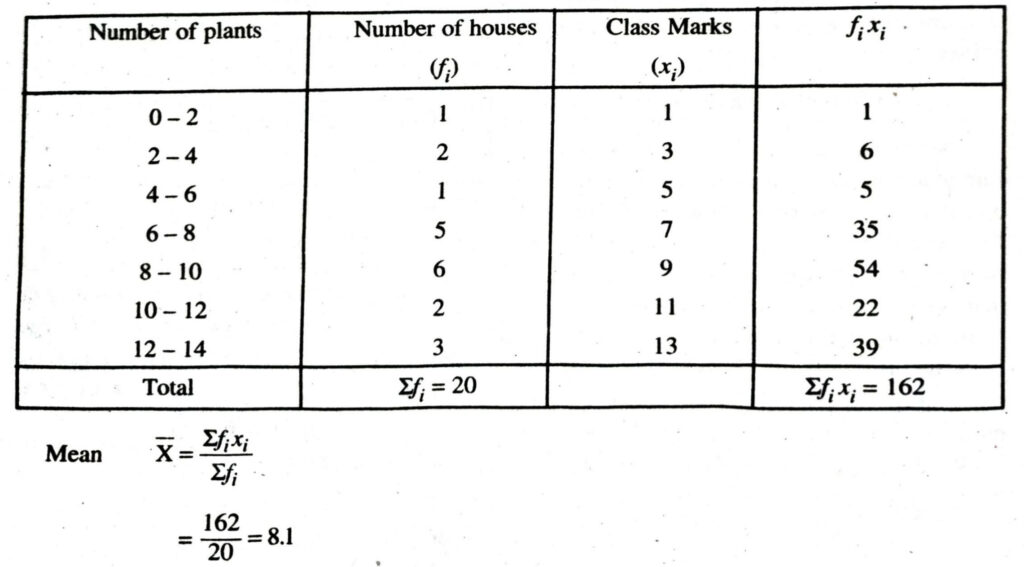
Hence, mean number of plants per house is 8.1. Ans.
Q. 2. Consider the following distribution of daily wages of 50 workers of a factory.
| Daily wages (in ₹) | 500 – 520 | 520 – 540 | 540 – 560 | 560 – 580 | 580 – 600 |
| Number of workers | 12 | 14 | 8 | 6 | 10 |
Find the mean daily wages of the workers of the factory by using an appropriate method.
Solution.
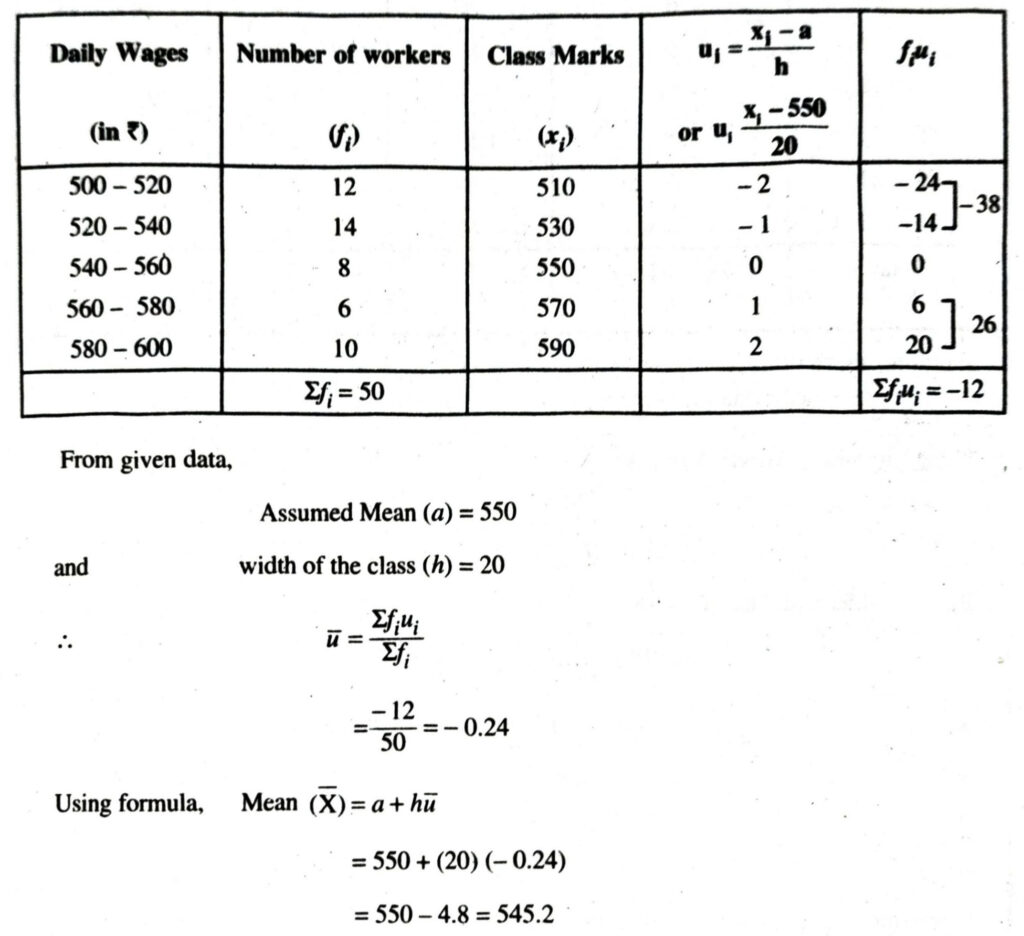
Hence, mean daily wages of the workers of factory is ₹ 545.20. Ans.
Q. 3. The following distribution shows the daily pocket allowance of children of a locality. The mean pocket allowance is 18. Find the missing frequency f.

Solution.
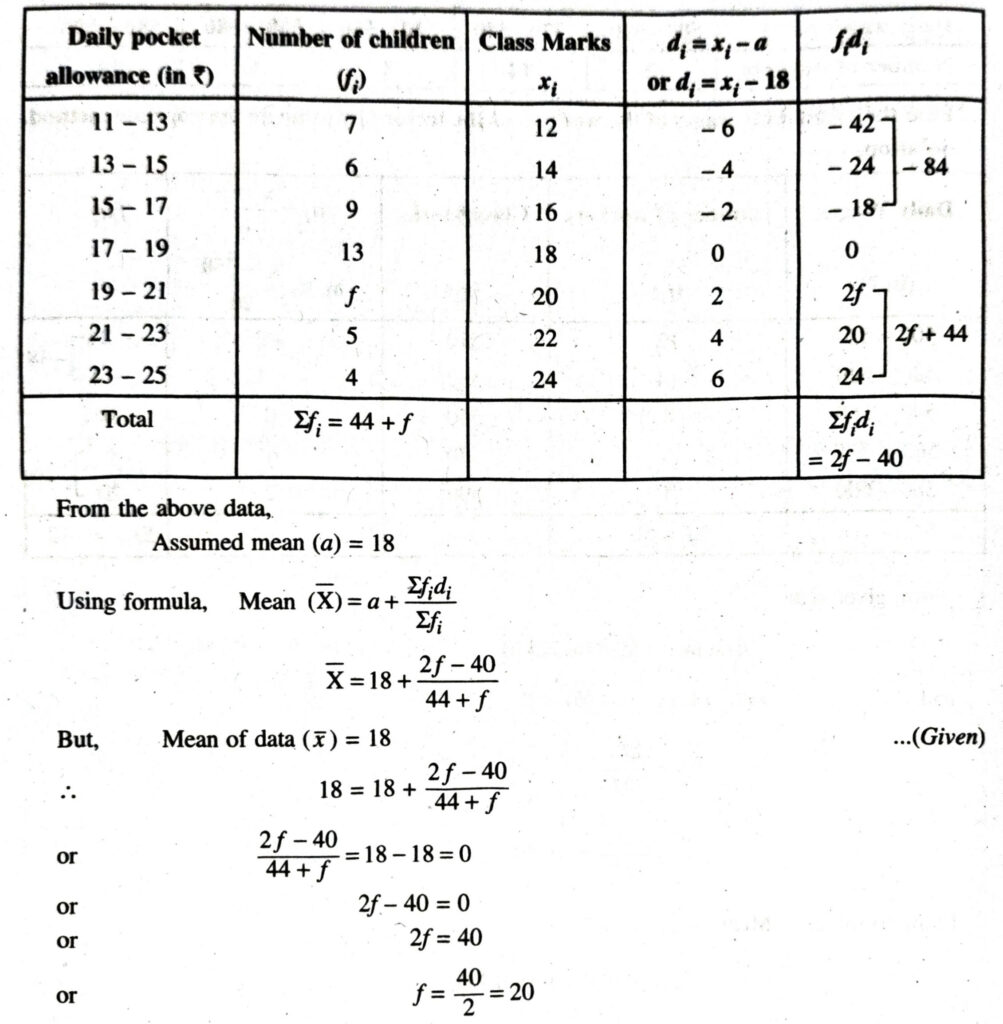
Hence, missing frequency ƒ is 20. Ans.
Q. 4. Thirty women were examined in a hospital by a doctor and the number of heart beats per minute were recorded and summarised as follows. Find the mean heart beats per minute for these women, choosing a suitable method.

Solution.

Hence, mean heart beats per minute for women is 75.89. Ans.
Q. 5. In a retail market, fruit vendors were selling mangoes kept in packing boxes. These boxes contained varying number mangoes. The following was the distribution of mangoes according to the number of boxes.

Find the mean number of mangoes kept in a packing box. Which method of finding the mean did you choose ?
Solution. Since, values of number of mangoes and number of boxes are large numerically. So, we must use step-deviation method.
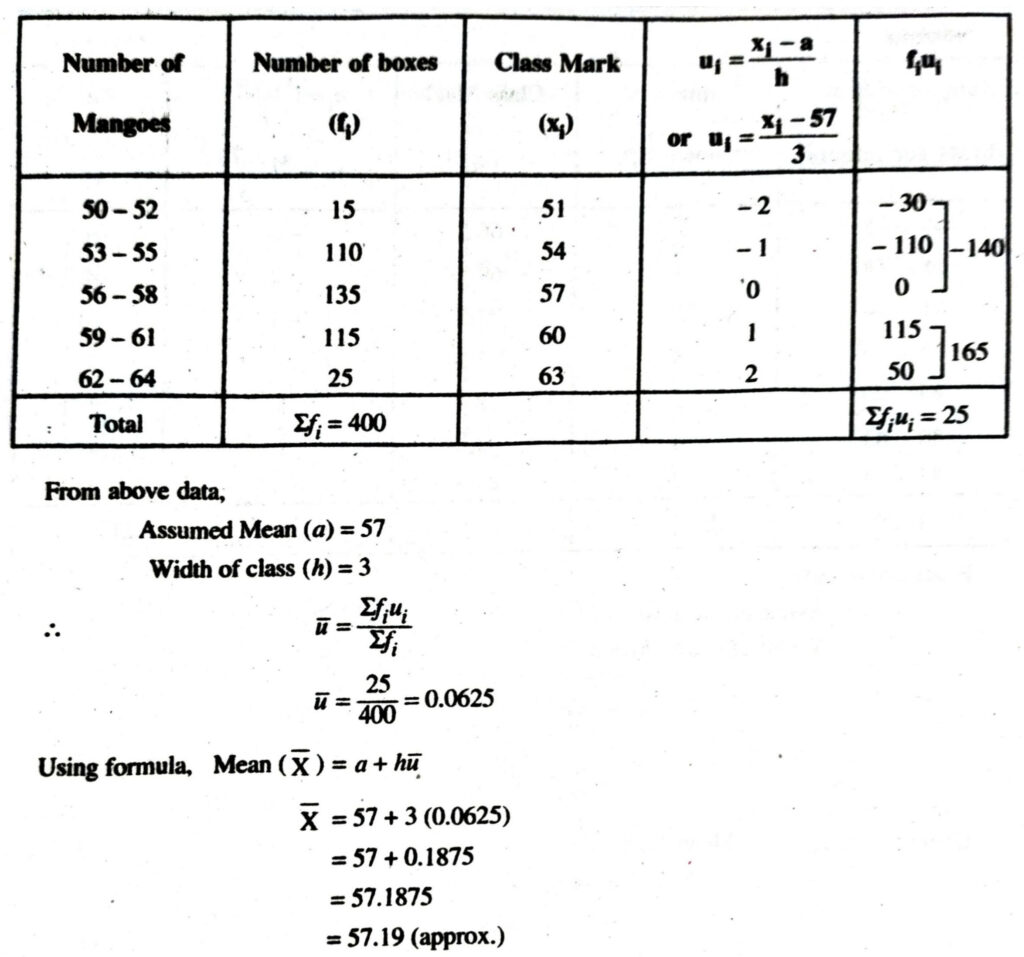
Hence, mean number of mangoes kept in a packing box is 57.19 Ans.
Q. 6. The table below shows the daily expenditure on food of 25 households in a locality.

Find the mean daily expenditure on food by a suitable method.
Solution.

Hence, mean daily expenditure on food is ₹ 211. Ans.
Q. 7. To find out the concentration of SO2 in the air (in parts per million, i.e., ppm), the data was collected for 30 localities in a certain city and is presented below :
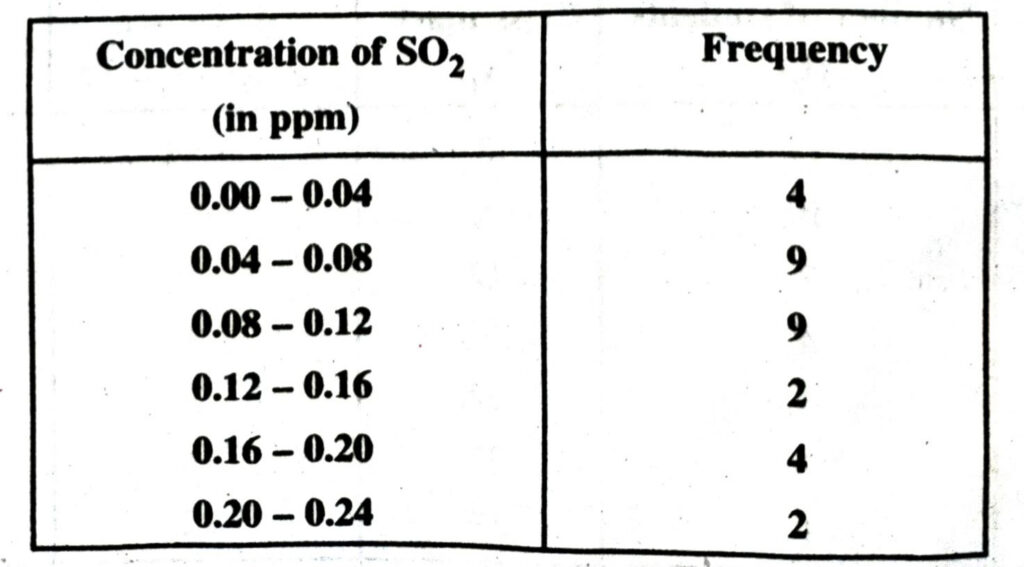
Find the mean concentration of SO2 in the air.
Solution.
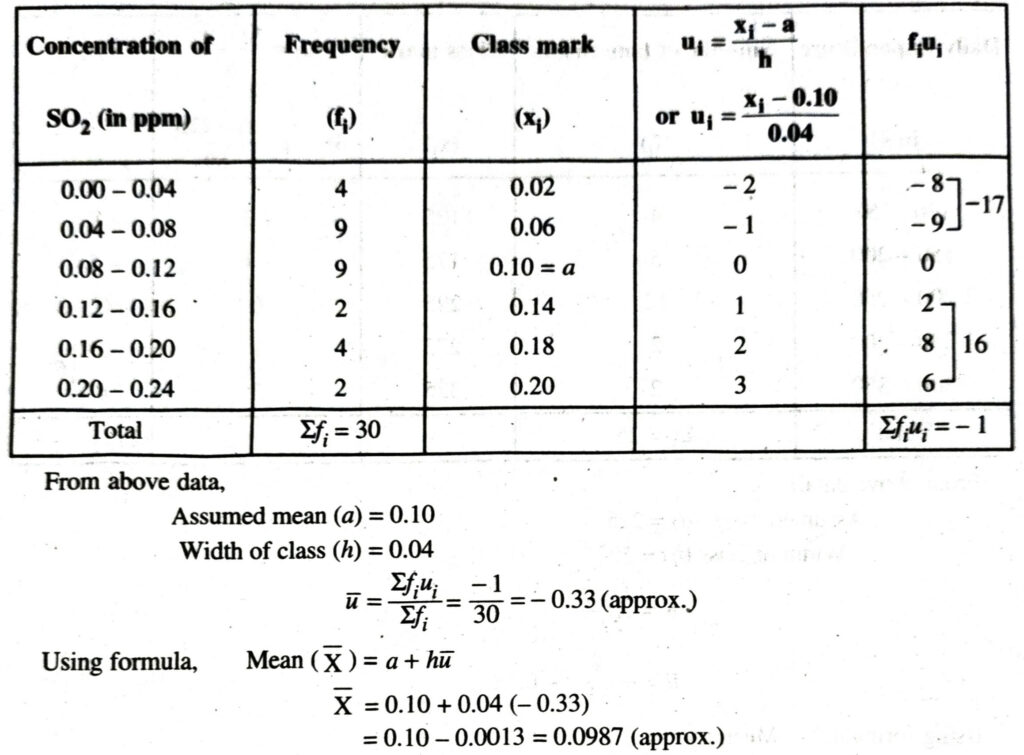
Hence, mean concentration of SO2 in the air is 0.0987 ppm. Ans.
Q. 8. A class teacher has the following absentee record of 40 students of a class for the Find the mean number of days a student was absent.
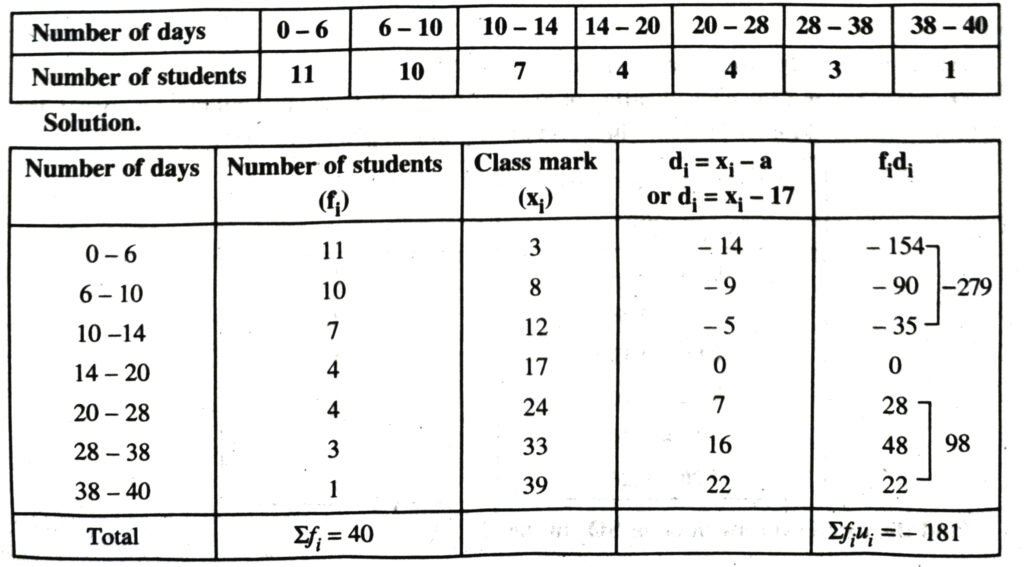
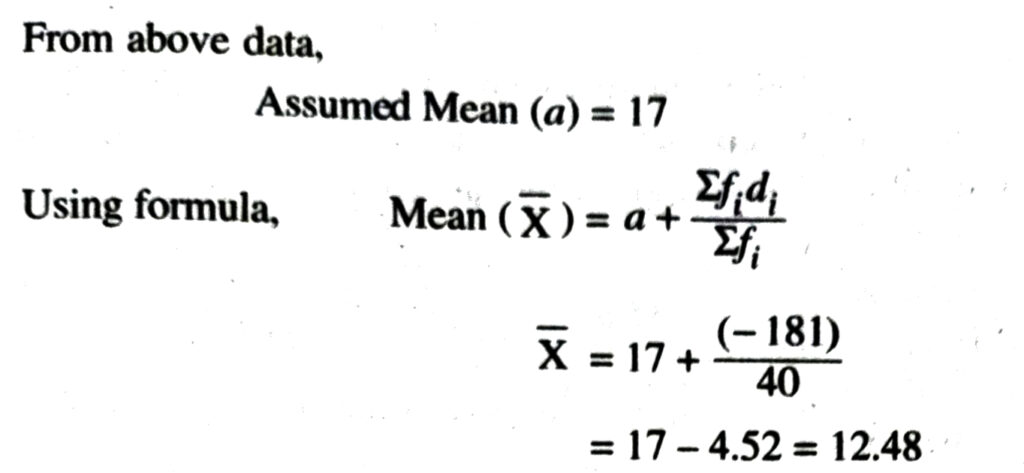
Hence, mean 12.48 number of days a student was absent. Ans.
Q.9. The following table gives the literacy rate (in percentage) of 35 cities. Find the mean Literacy rate.
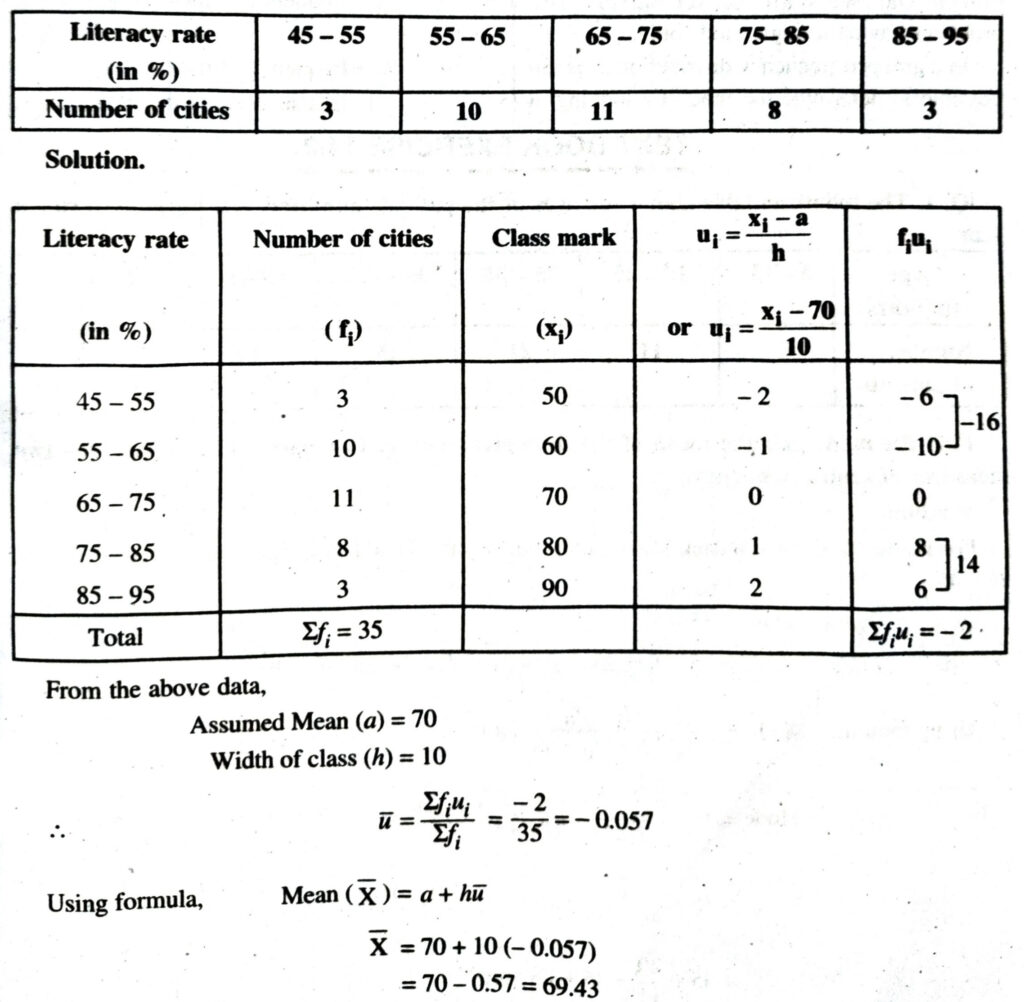
Hence, mean literacy rate is 69.43%. Ans.
TEXT BOOK EXERCISE 14.2
Q.1. The following table shows the ages of the patients admitted in a hospital during a year:

Find the mode and the mean of the data given above. Compare and interpret the two measures of central tendency.
Solution.
For mode: In the given data, Maximum frequency is 23 and it corresponds to the class interval 35-45
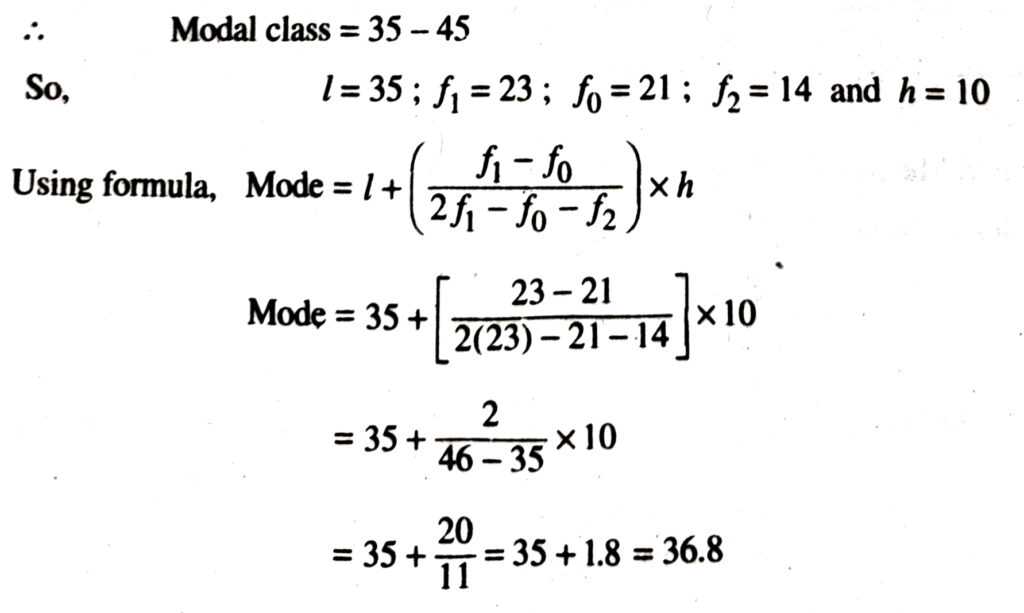
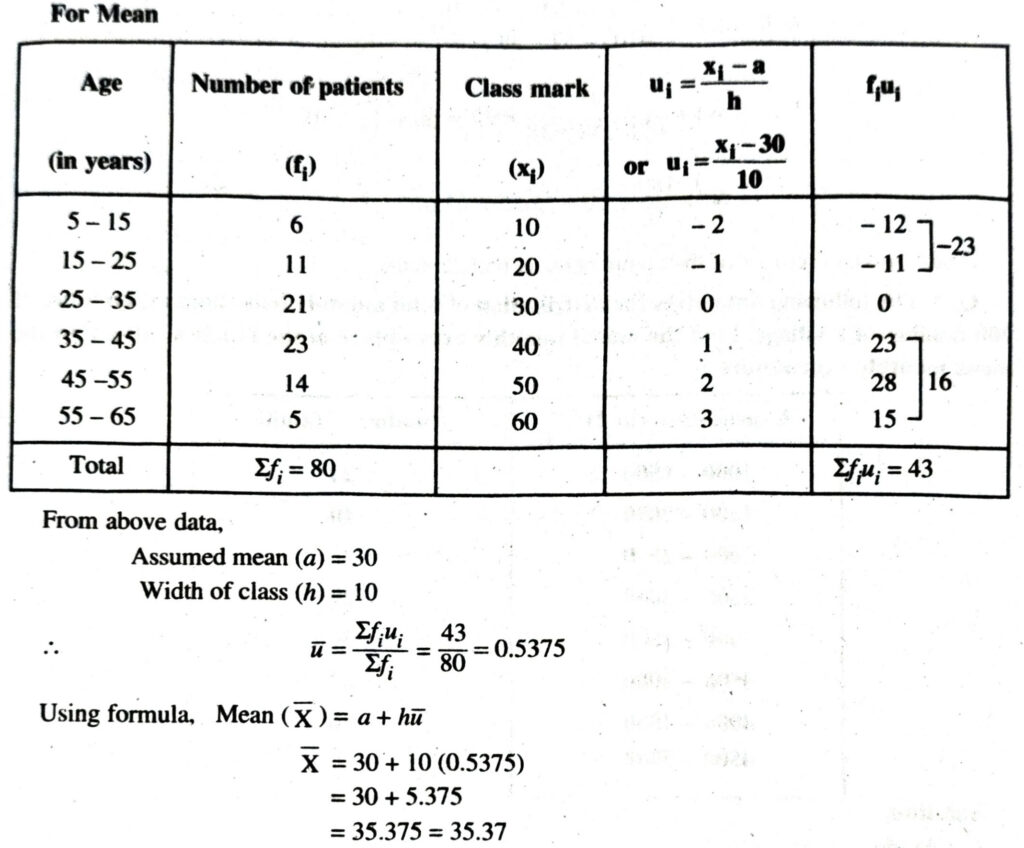
Hence, mode of given data is 36.8 years and mean of the given data is 35.37 years.
Also, it is clear from above discussion that average age of a patient admitted in the hospital is 35.37 years and maximum number of patients admitted in the hospital are of age 36.8 years. Ans.
Q. 2. The following data gives the information on the observed lifetimes (in hours) of 225 electrical components:

Determine the modal lifetimes of the components.
Solution. In the given data,
Maximum frequency is 61 and it corresponds to the class interval 60 – 80.

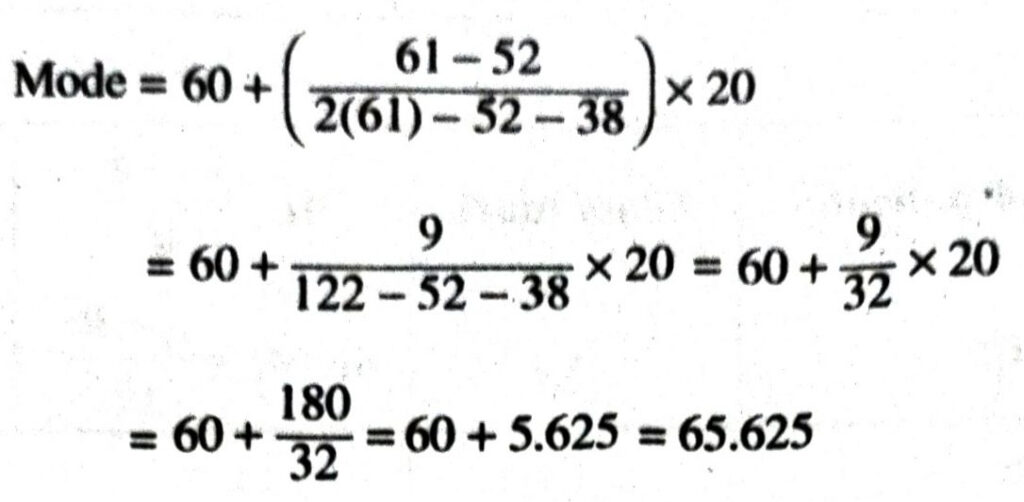
Hence, modal lifetimes of the components is 65.625 hours.
Q. 3. The following data gives the distribution of total monthly household expenditure of 200 families of a village. Find the modal monthly expenditure of the families. Also, find the mean monthly expenditure :
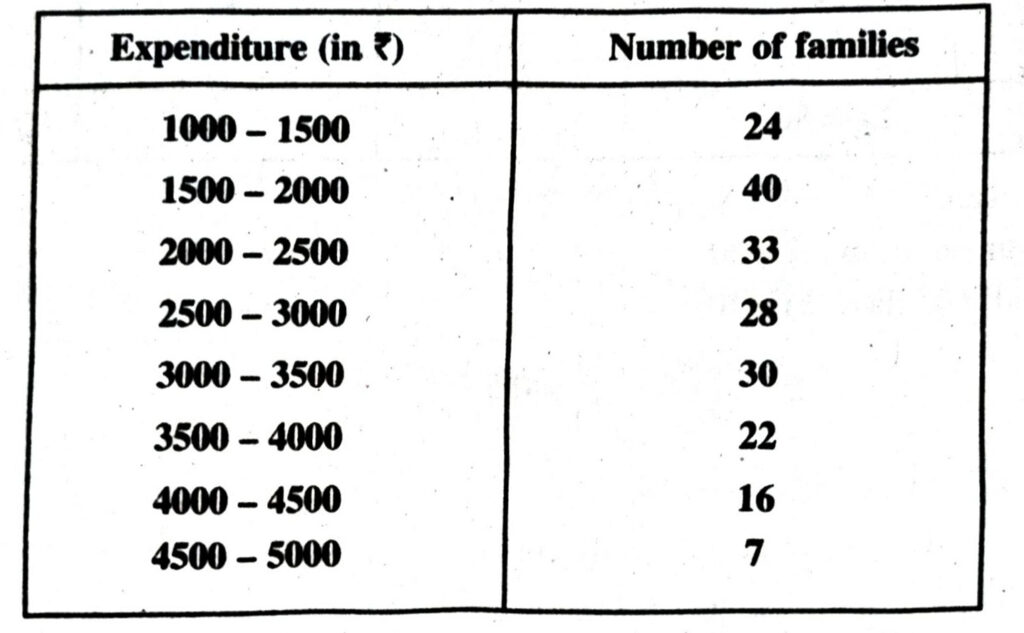
Solution.
For Mode: In the given data,
Maximum frequency is 40 and it corresponds to the class interval 1500 – 2000.
∴ Model class = 1500-2000
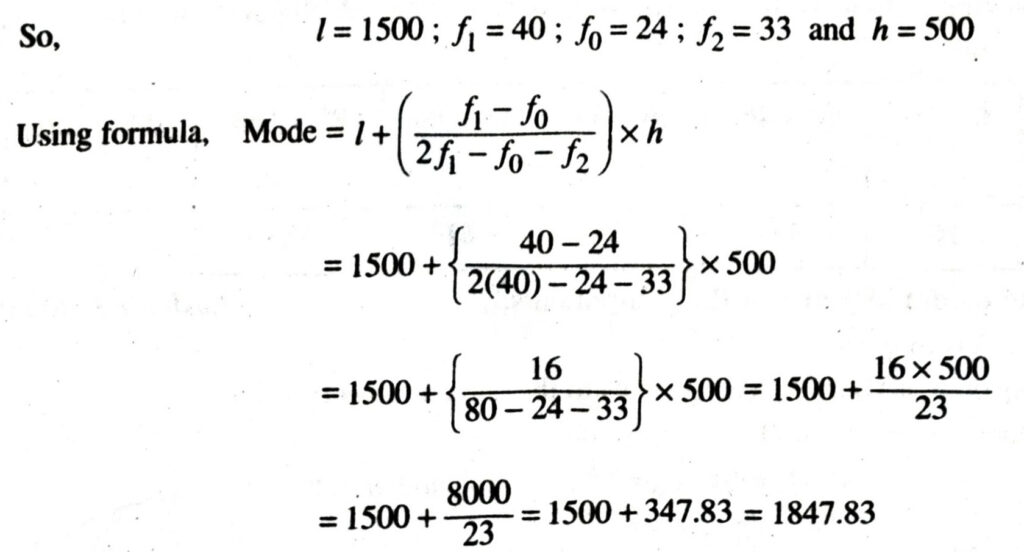
For mean
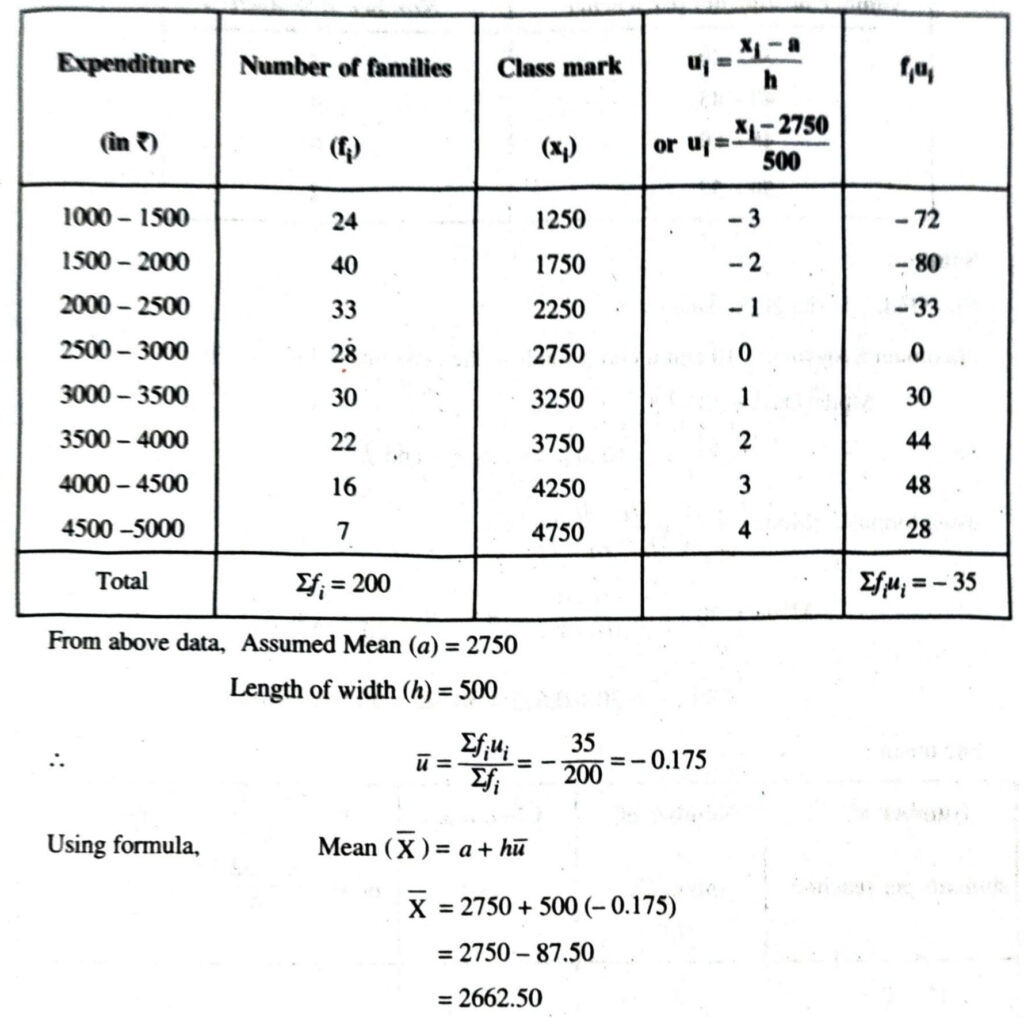
Hence, the modal monthly expenditure of family is ₹ 1847.83 and the mean monthly expenditure is ₹ 2662.50. Ans.
Q. 4. The following distribution gives the state-wise teacher-student ratio in higher secondary schools of India. Find the mode and mean of this data. Interpret, the two measures.
| Number of students per teacher | Number of States/U.T. |
|
15 – 20
20 – 25
25 – 30
30 – 35
35 – 40
40 – 45
45 – 50
50 – 55
|
3
8
9
10
3
0
0
2
|
Solution
For Mode: In the given data,
Maximum frequency is 10 and it corresponds to the class interval is 30 – 35.
∴ Modal class = 30-35.
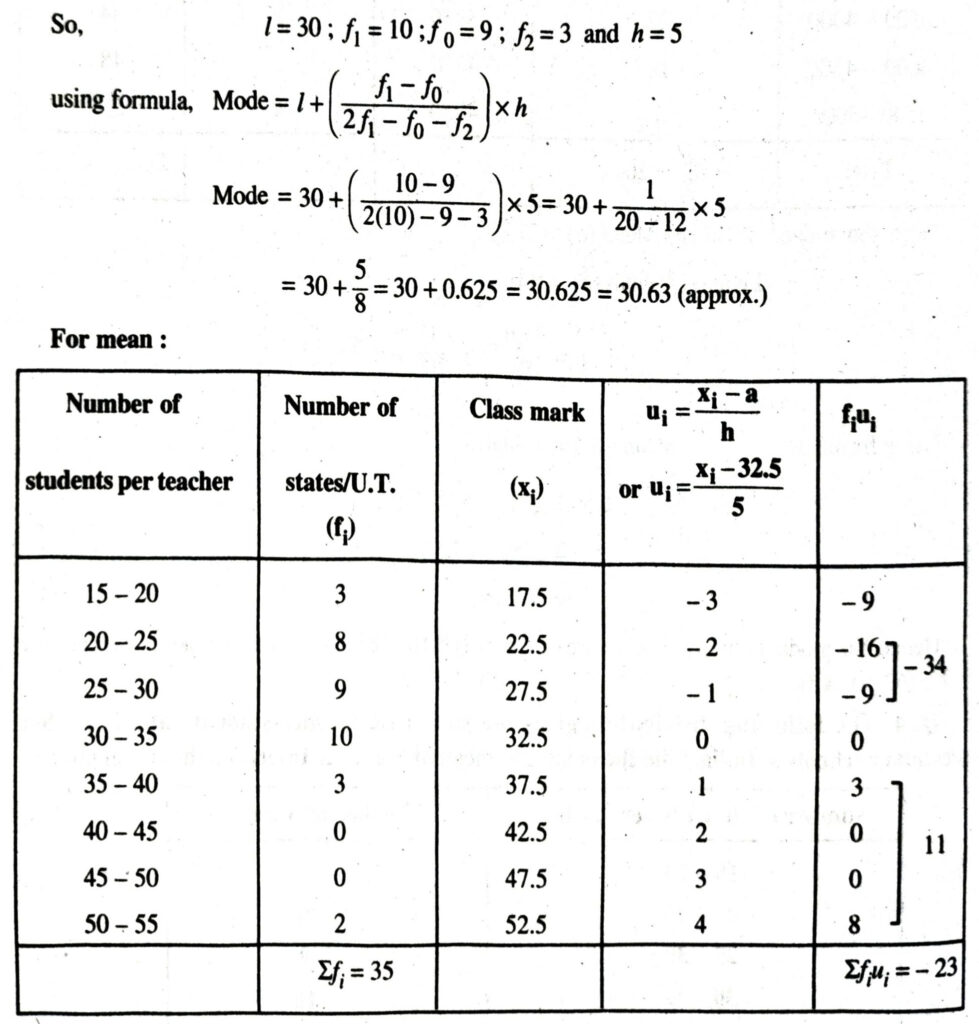
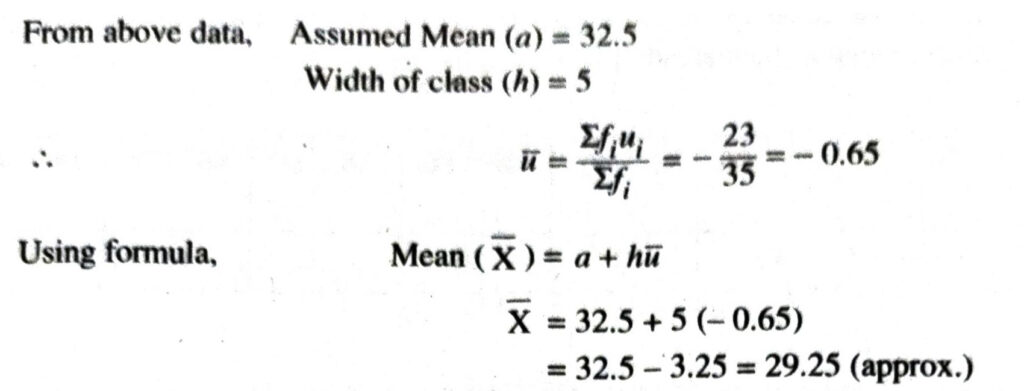
Hence, mode and mean of given data is 30.63 and 29.25. Also, from above discussion, it clear that states/U.T. have student per teacher is 30.63 and on average, this ratio is 29.25. Ans.
Q. 5. The given distribution shows the number of runs scored by some top batsmen of the world in one-day international cricket matches
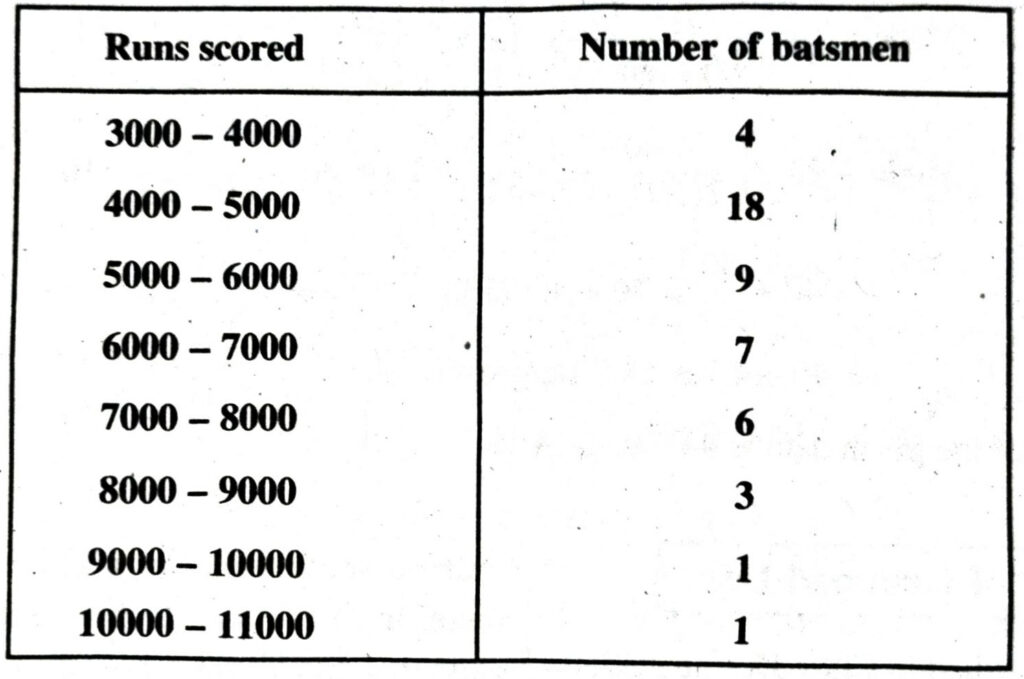
Find the mode of the data.
Solution. In the given data,
Maximum frequency is 18 and it corresponds to the class interval 4000 – 5000.
∴ Modal class = 4000-5000
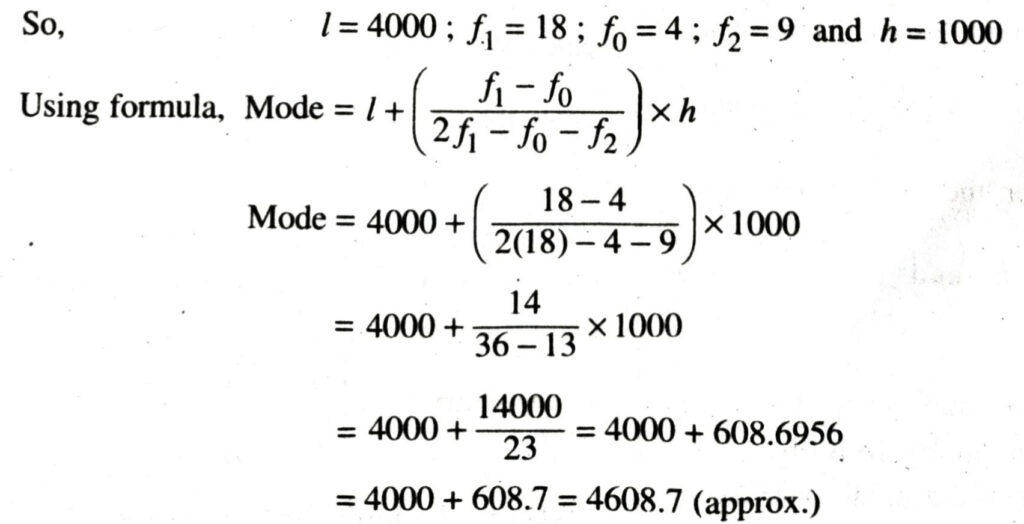
Hence, mode of the given data is 4608.7 runs. Ans.
Q. 6. A student noted the number of cars passing through a spot on a road for 100 periods each of 3 minutes and summarised it in the table given below. Find the mode of the data :

Solution. In the given data,
Maximum frequency is 20 and it corresponds to the class interval 40 – 50
∴ Modal Class = 40-50
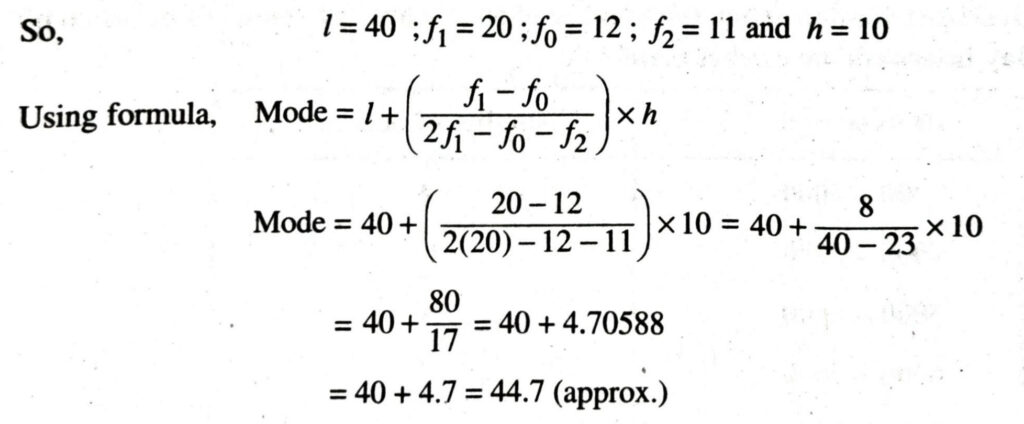
Hence, mode of the given data is 44.7 cars. Ans.
TEXT BOOK EXERCISE 14.3
Q. 1. The following frequency distribution gives the monthly consumption of electricity of 68 consumers of a locality. Find the median, mean and mode of the data and compare them.
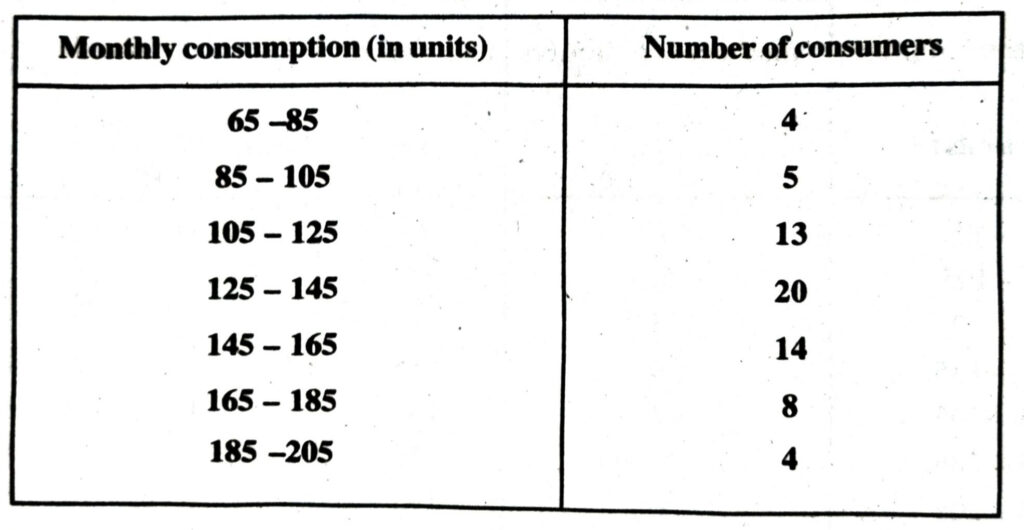
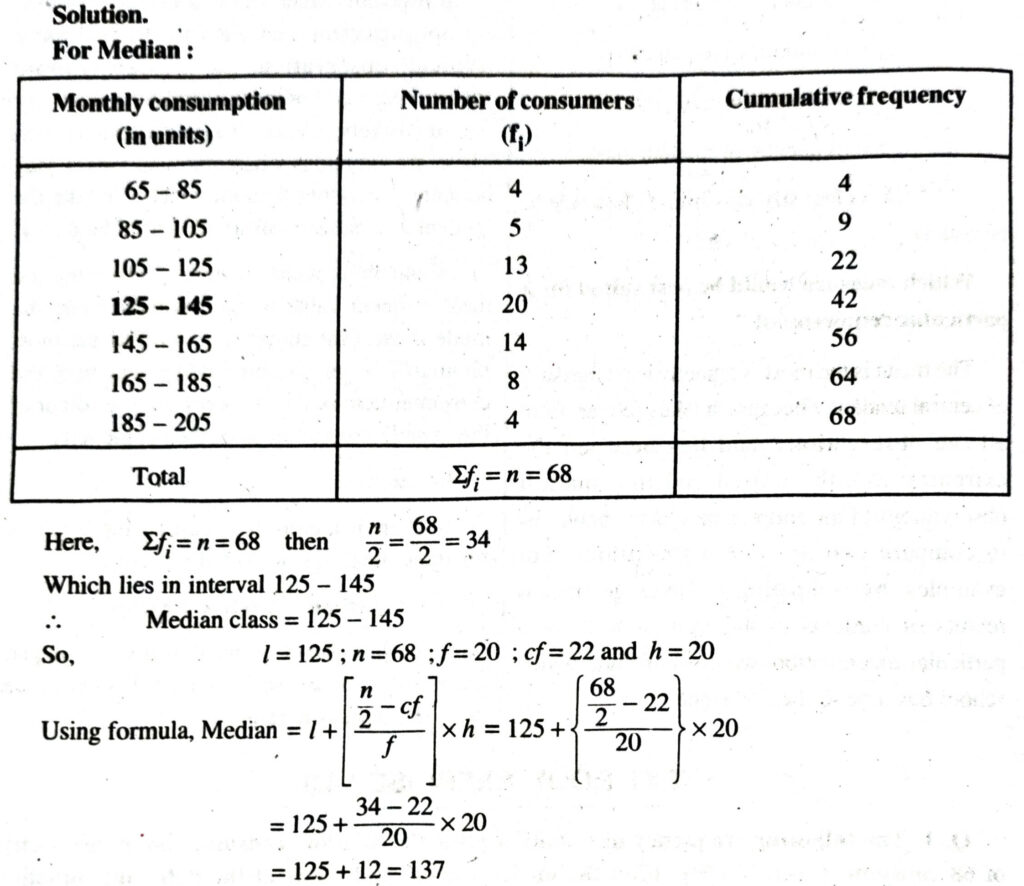
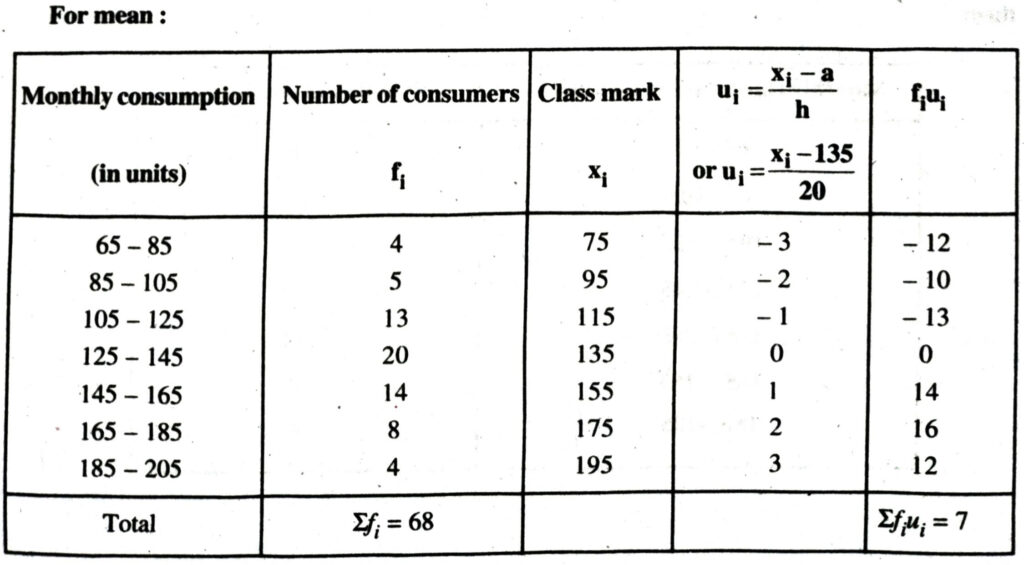
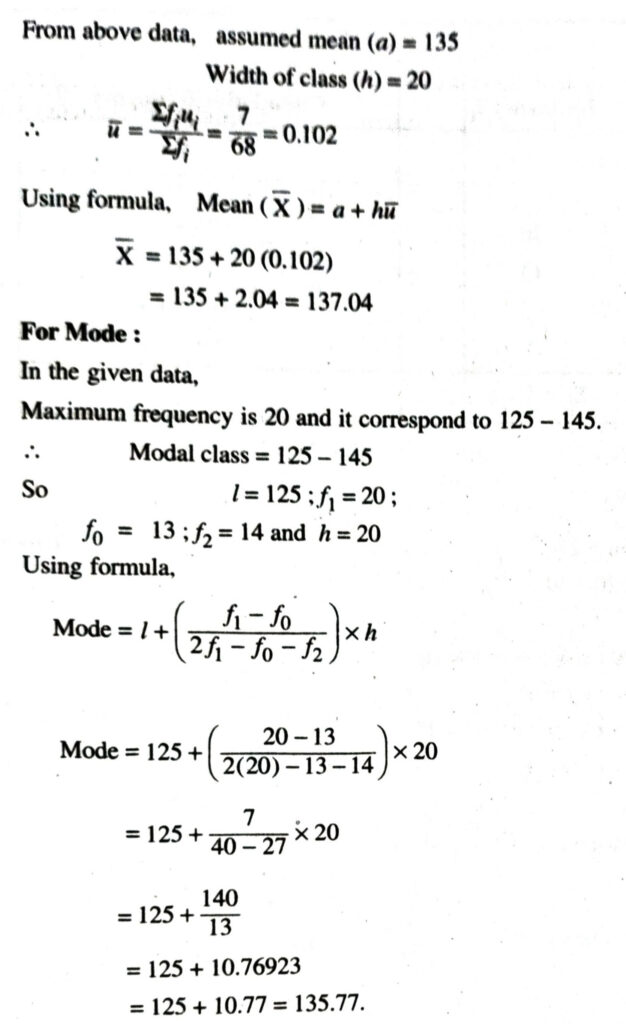
Hence, median, mean and mode of given data is 137 units; 137.04 units and 135.77 units. Ans.
Q. 2. If the median of the distribution given below is 28.5, find the values of x and y.
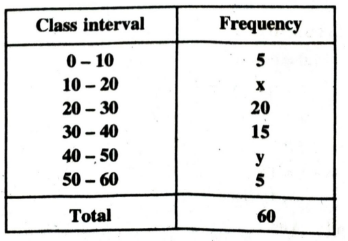
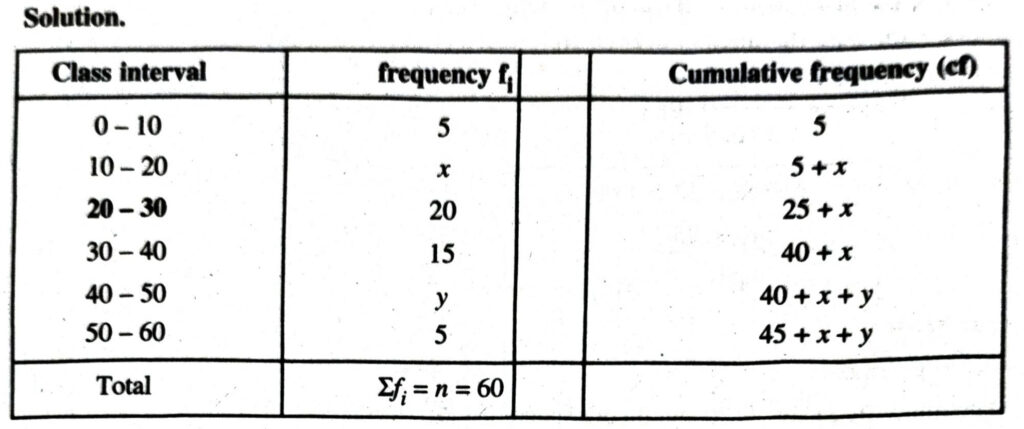
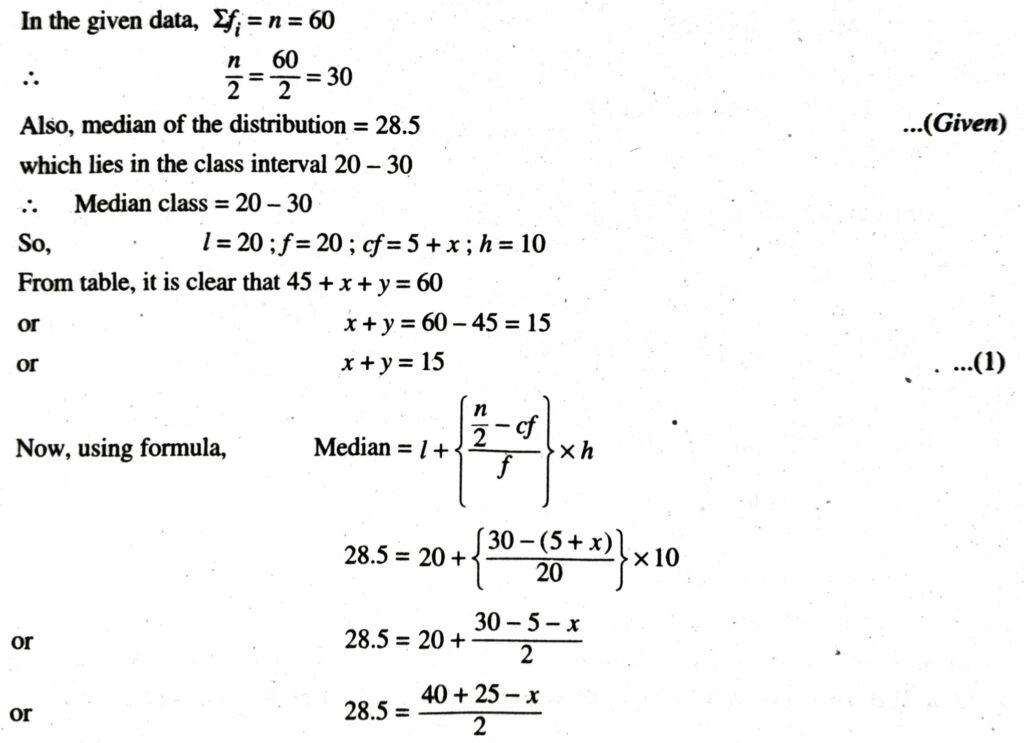
or 2(28.5) = 65 – x
or 57.0 = 65 – x
or x = 65 – 57 = 8
∴ x = 8
Substitute this value of x in (1), we get
8 + y = 15
y = 15 – 8 = 7
Hence, values of x and y is 8 and 7. Ans.
Q. 3. A life insurance agent found the following data for distribution of ages of 100 policy holders. Calculate the median age, if policies are only given to person having age 18 years onwards but less than 60 years.
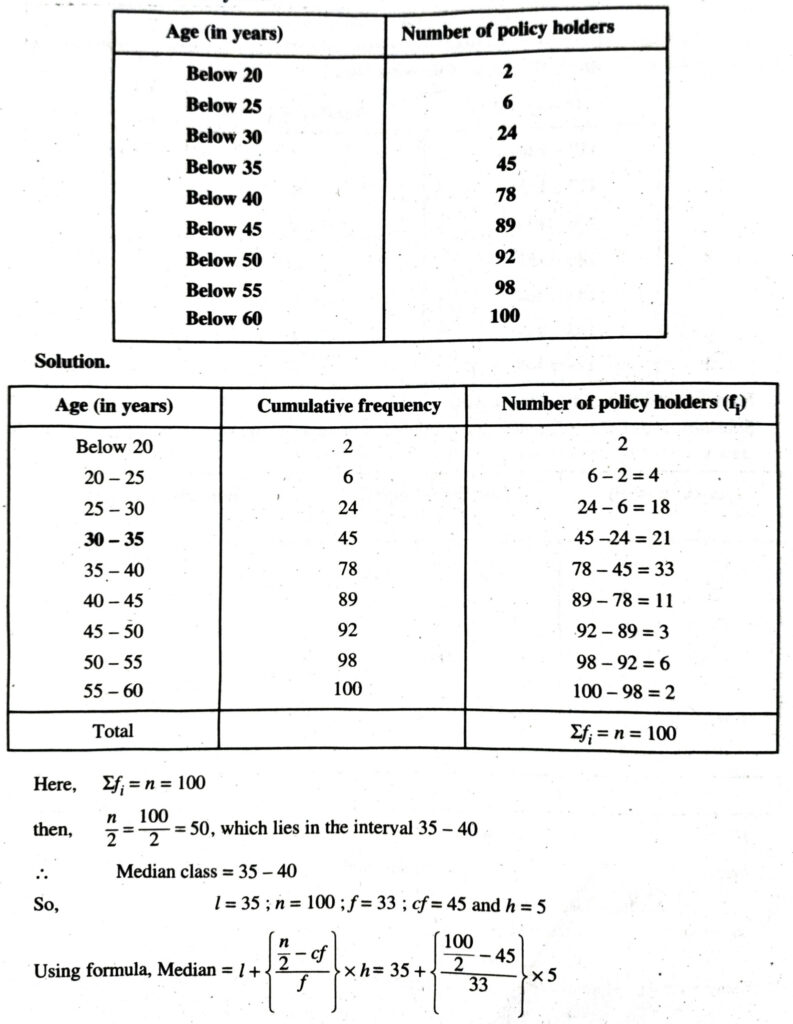

Hence, median age of given data is 35.76 years. Ans.
Q. 4. The lengths of 40 leaves of a plant are measured correct to the nearest millimetre, and the data obtained is represented in the following table :
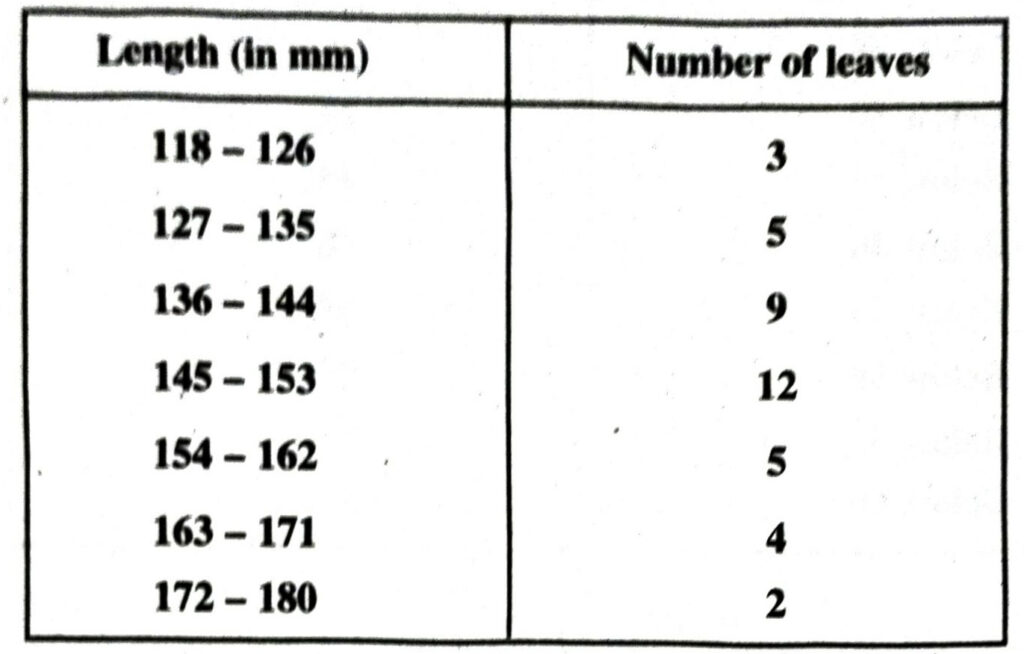
Find the median length of the leaves.
Solution. Since the frequency distribution is not continuous, so firstly we shall make it continuous.
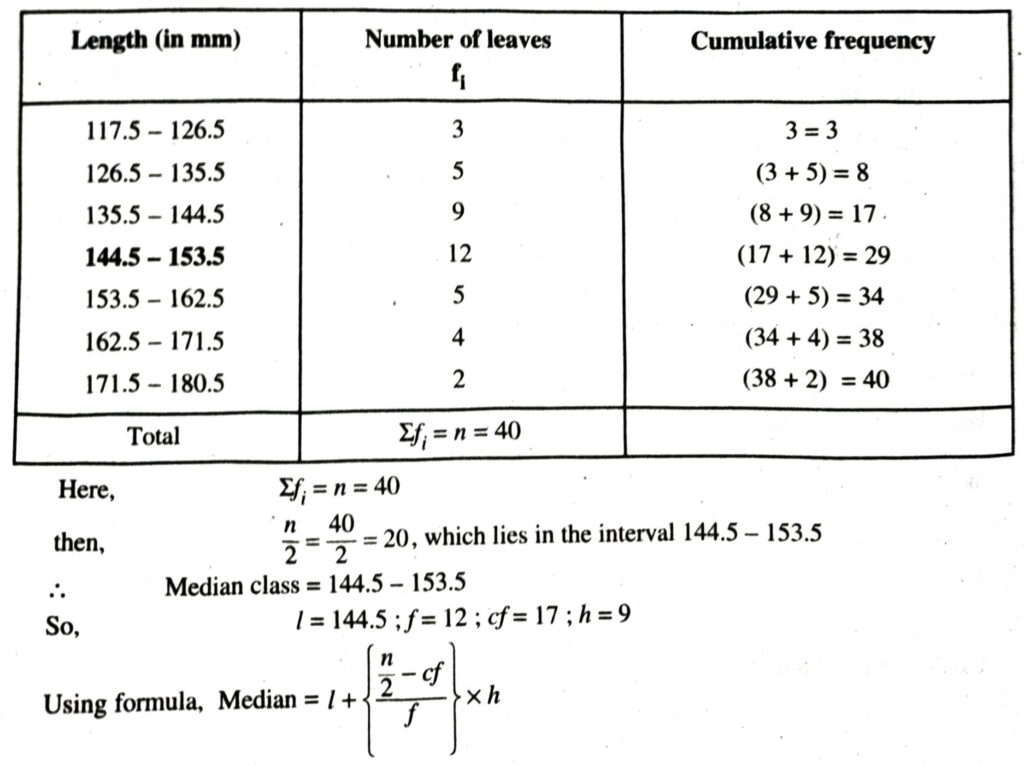

Hence, median length of the leaves is 146.75 mm Ans.
Q. 5. The following table gives the distribution of the life time of 400 neon lamps:
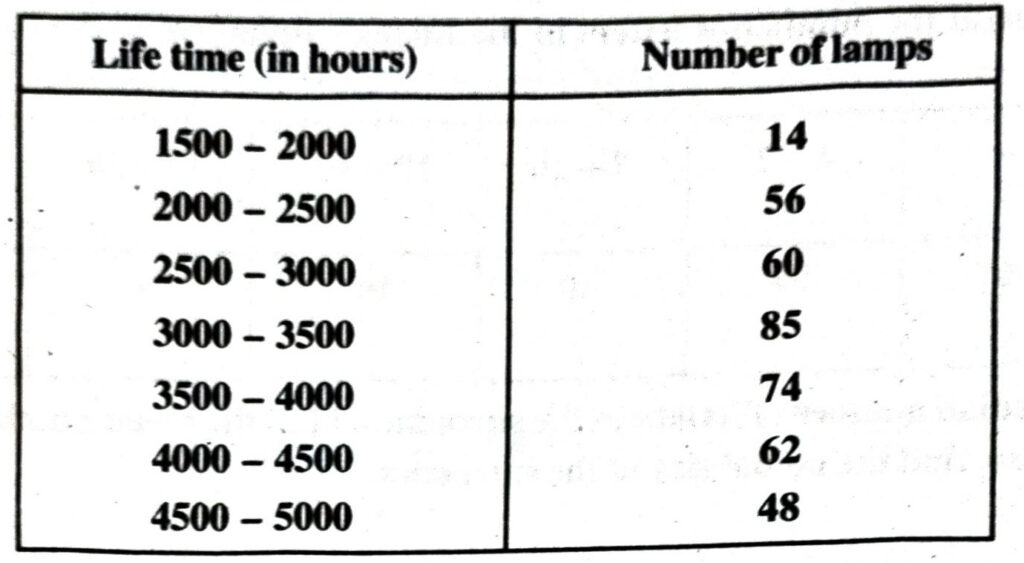
Find the median life time of a lamp.
Solution.
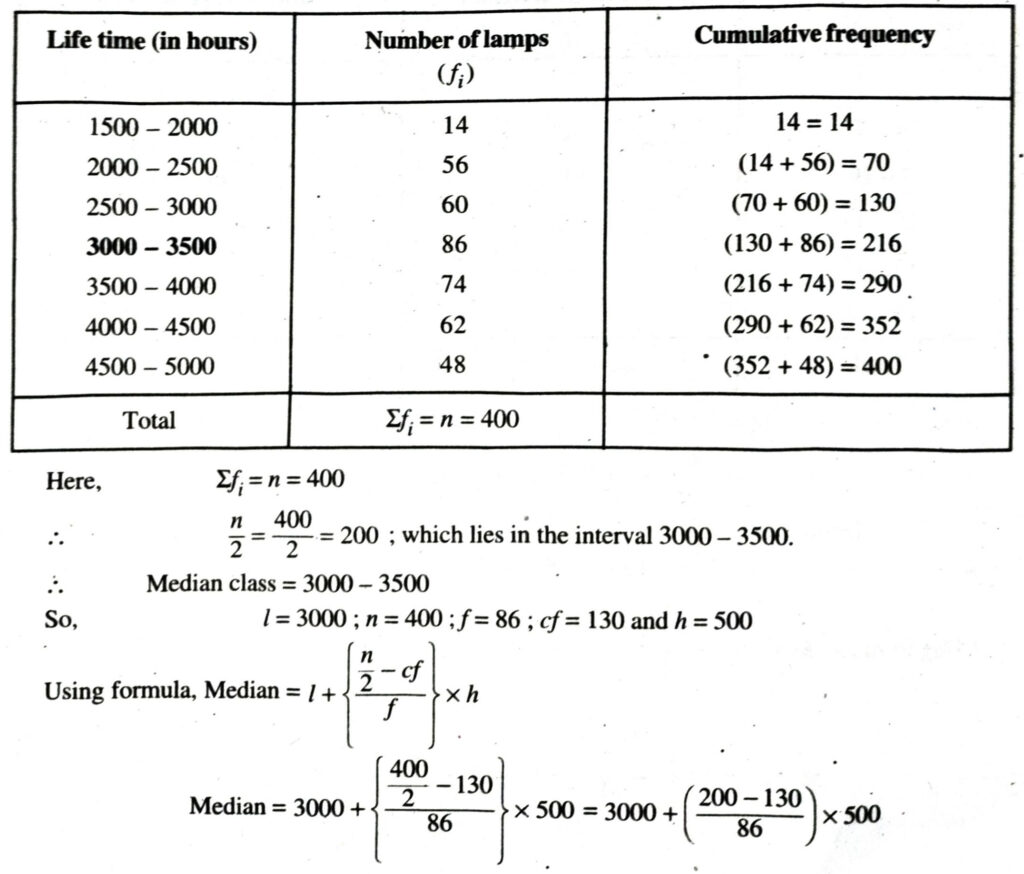
= 3000 + 70×500/86 = 3000 + 406.9767441
= 3000 + 406.98 (approx.) = 3406.98
Hence, median life time of a lamp is 3406.98 hours. Ans.
Q. 6. 100 surnames were randomly picked up from a local telephone directory and the frequency distribution of the number of letters in the English alphabets in the surnames was obtained as follows:

Determine the median number of letters in the surnames. Find the mean number of letters in the surnames ? Also, find the modal size of the surnames.
Solution.
For Median:
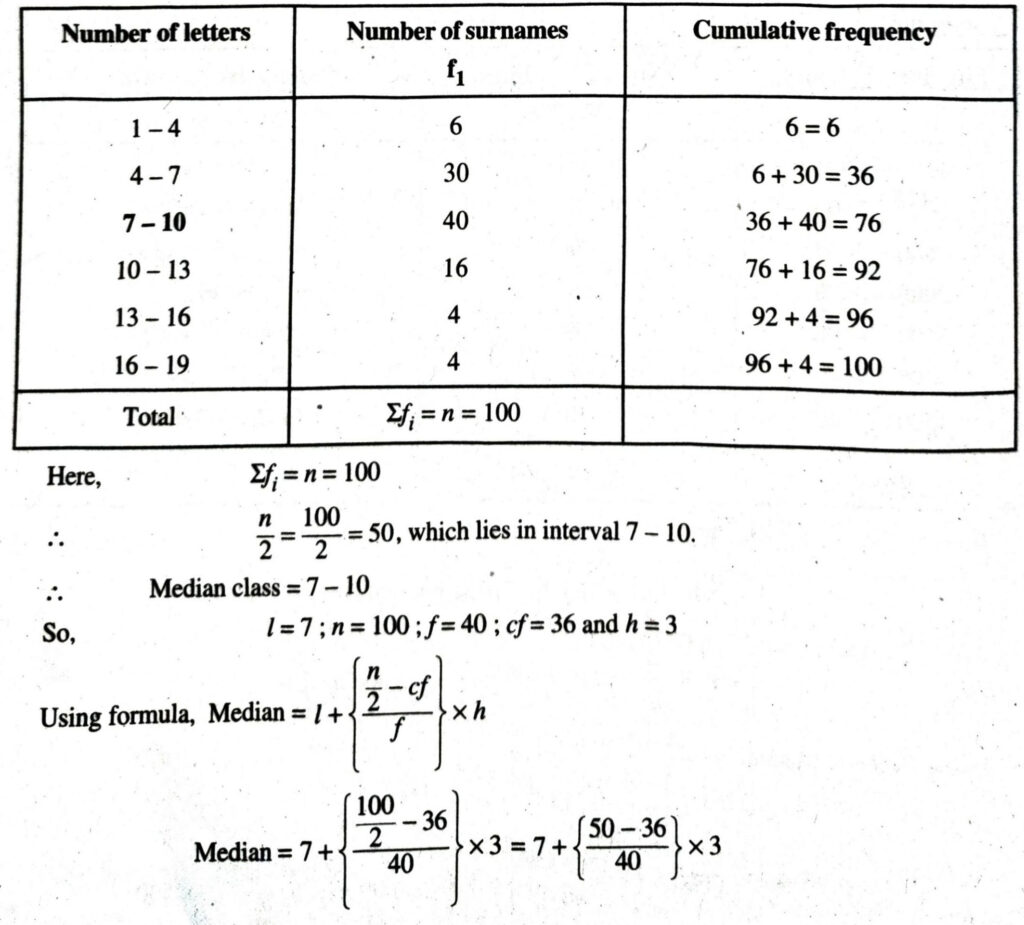

Hence, the median of letters in the surnames is 8.05 Ans.
For Mean:
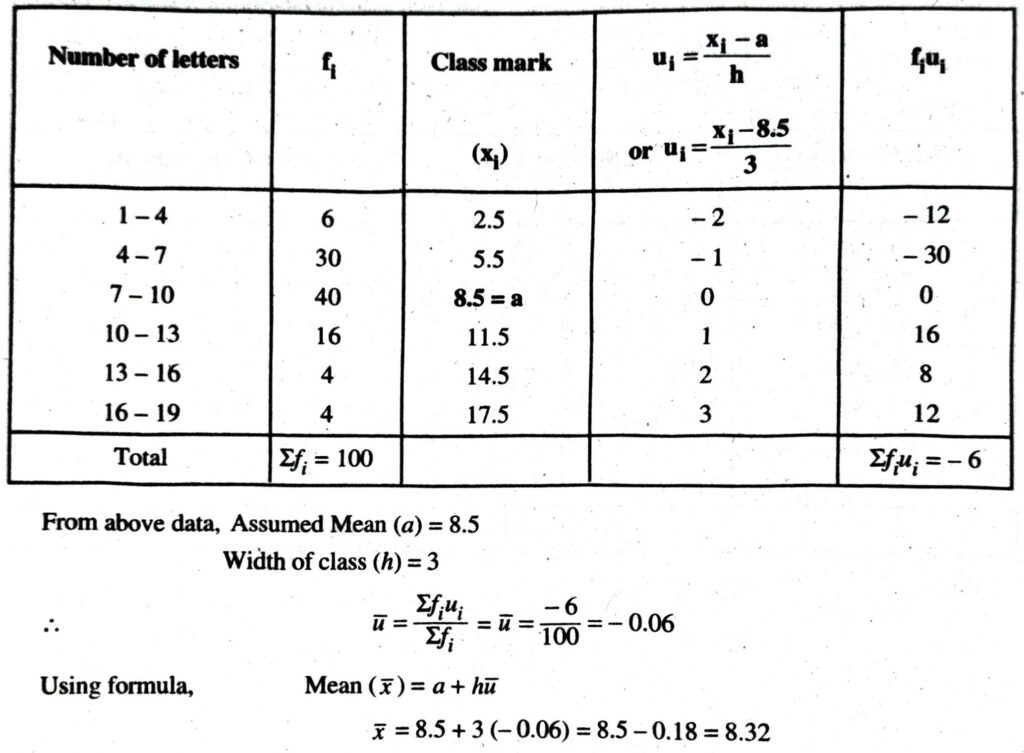
Hence, mean number of letters in the surnames is 8.32 letters. Ans.
For Modal:
In the given data Maximum frequency is 40 and it corresponds to interval 7 – 10
∴ Modal class = 7 – 10
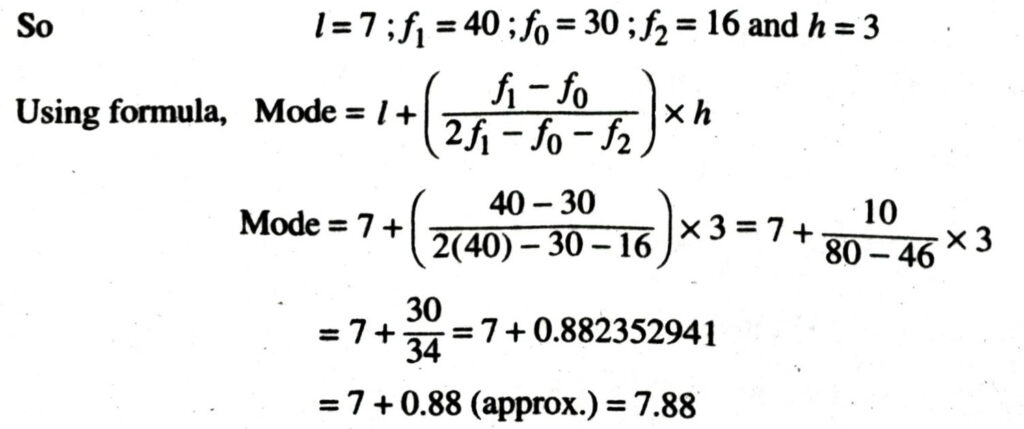
Hence, modal size of the surnames is 7.88 letters. Ans.
Q. 7. The distribution below gives the weights of 30 students of a class. Find the median weight of the students.
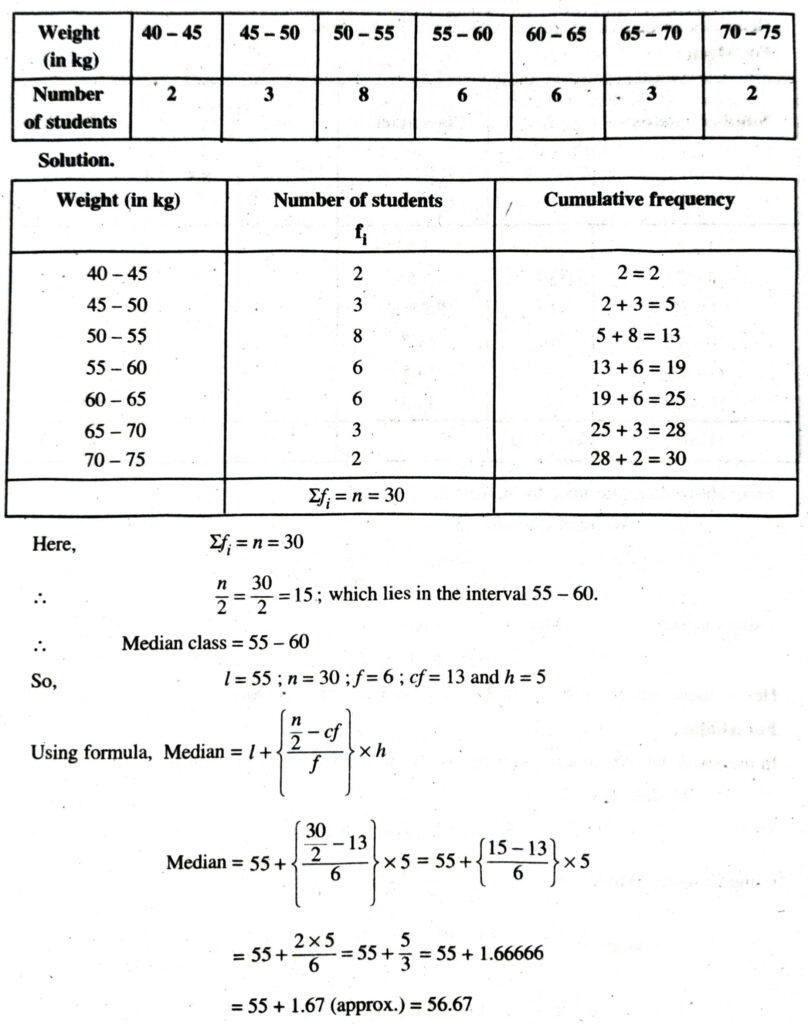
Hence. median weight of the students are 56.67 kg. Ans.
TEXT BOOK EXERCISE 14.4
Q. 1. The following distribution gives the daily income of 50 workers of a factory.

Convert the distribution above to a less than type cumulative frequency distribution and draw its ogive.
Solution.
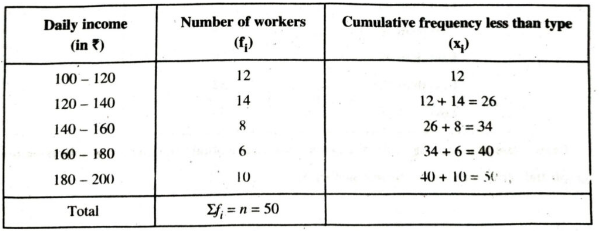
Now, by drawing the points on the graph
i.e. (120, 12); (140, 26); (160, 34); (180, 40); (200, 50).
We get graph of less than type cumulative frequency.
Scale chosen: On x-axis 10 units = ₹ 10
On y-axis 10 units = 5 workers.

Q. 2. During the medical check up of 35 students of a class, their weights were recorded as follows:
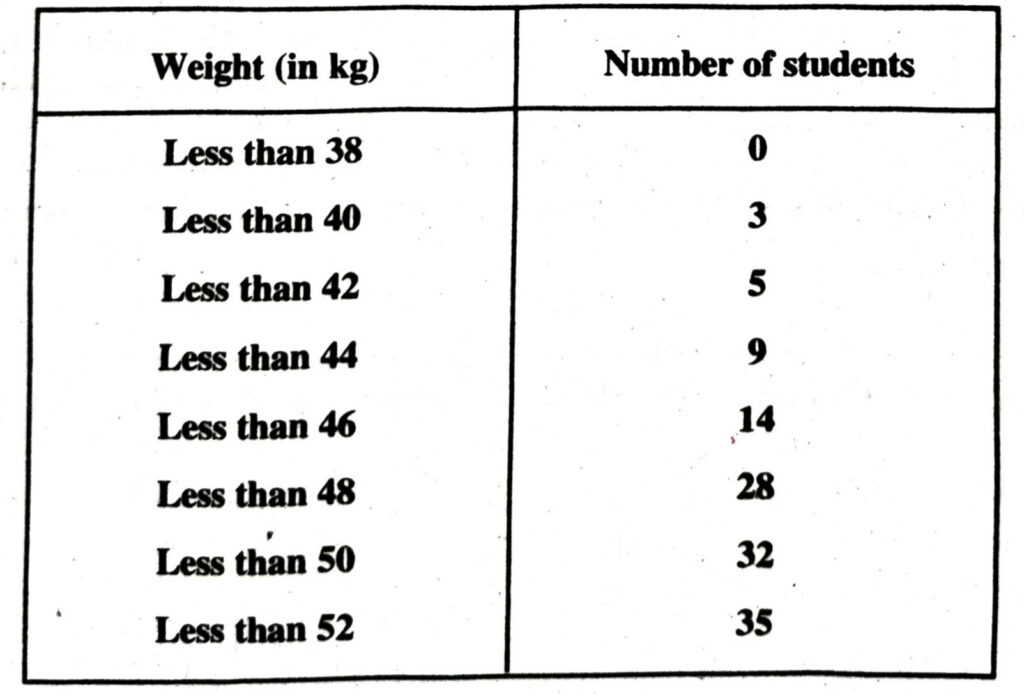
Draw a less than type ogive for the given data. Hence obtain the median weight from the graph and verify the result by using the formula.
Solution.
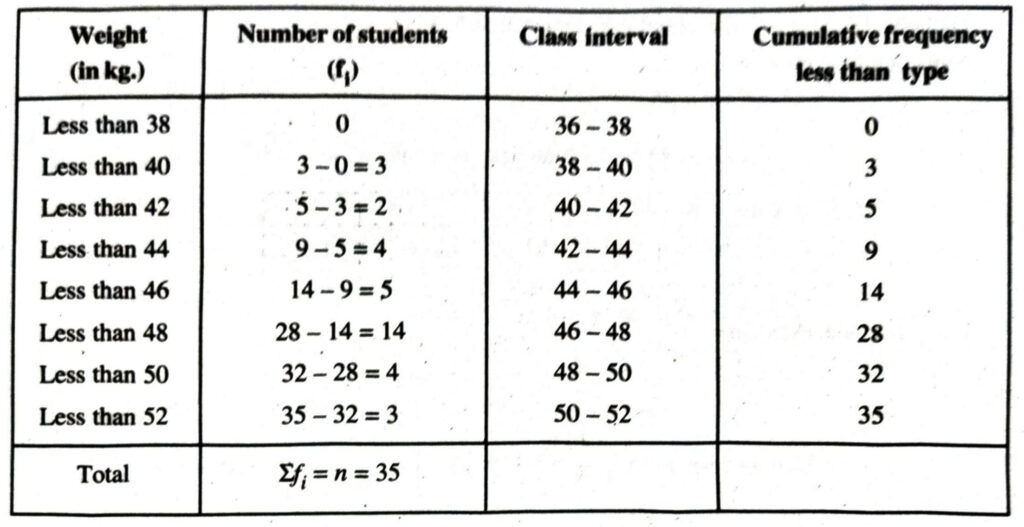
Now, By drawing the points on the graph i.e., (38, 0); (40, 3); (42, 5); (44, 9); (46, 14); (48, 28); (50, 32); (52, 35) we get graph of less than type cumulative frequency.
Scale Chosen :
On x-axis, 10 units = 2 kg
On y-axis units = 5 students
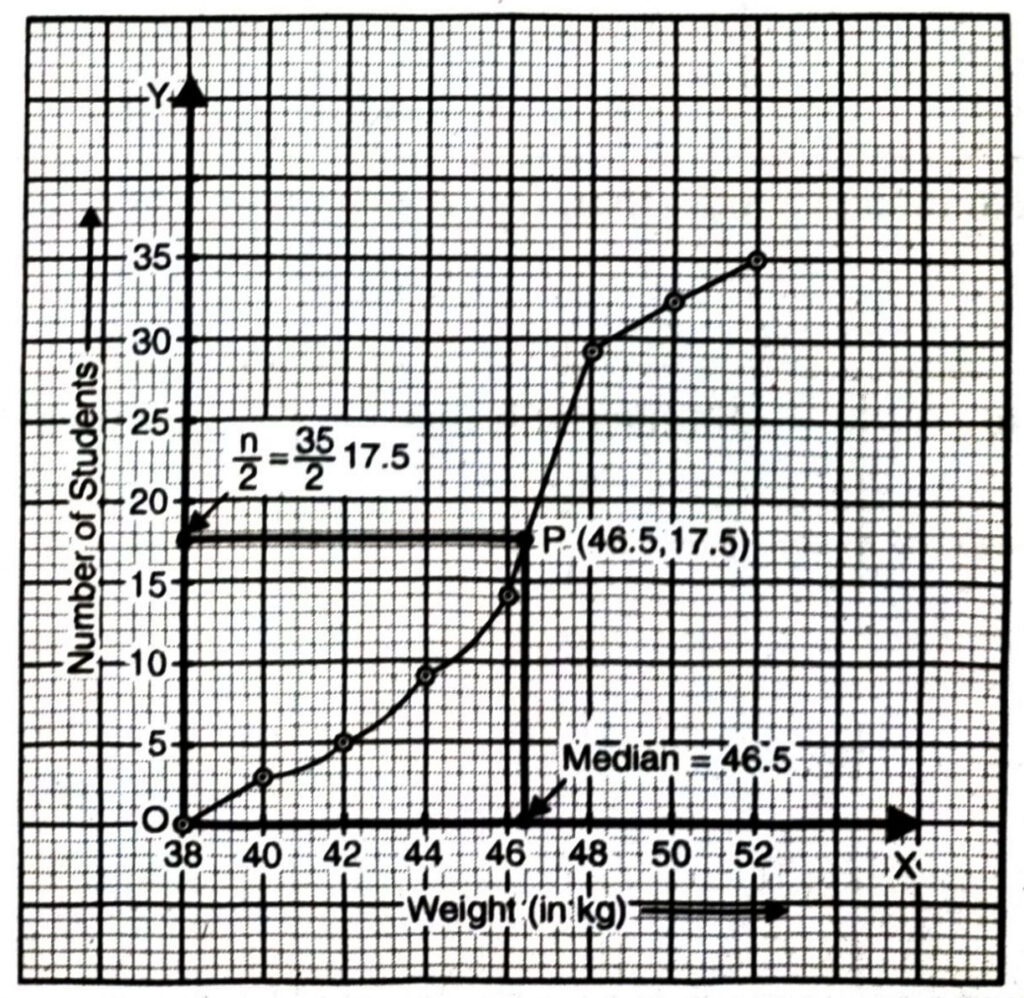
From above graph, it is clear that
Median = 46.5 kg; which lies in class interval 46-48.
Now, in the given table
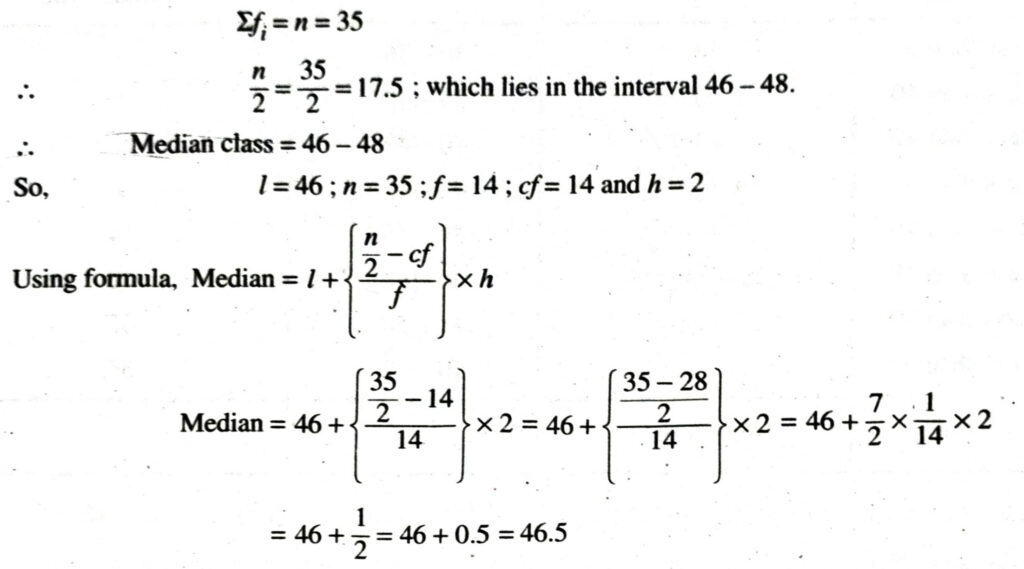
From above discussion and graph; it is clear that median is same in both cases.
Hence, Median weight of students is 46.5 kg. Ans.
Q. 3. The following table gives production yield per hectare of wheat of 100 farms of a village.

Change the distribution to a more than type distribution, and draw its ogive.
Solution.
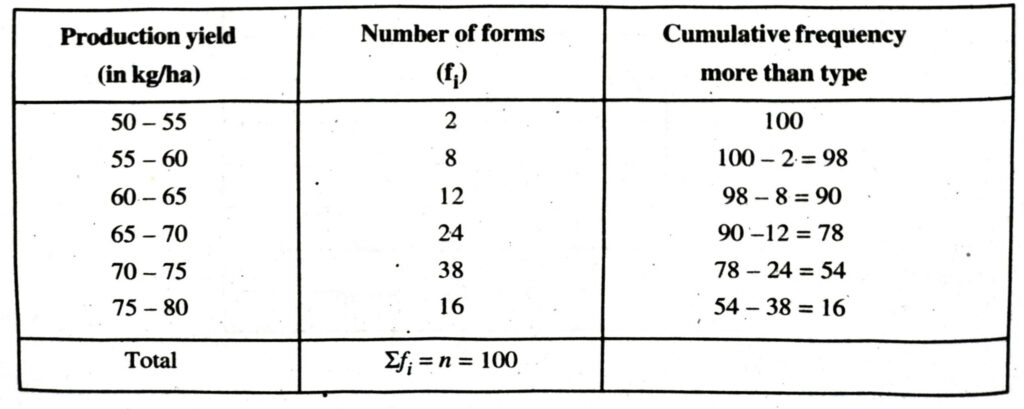
Now, by drawing the points on the graph i.e. (50, 100); (55, 98); (60, 90) ; (65, 78) ; (70, 54); (75, 16) we get graph of more than type cumulative frequency.
Scale chosen: On x-axis 10 units = 5 kg/ha
On y-axis 10 units = 10 forms
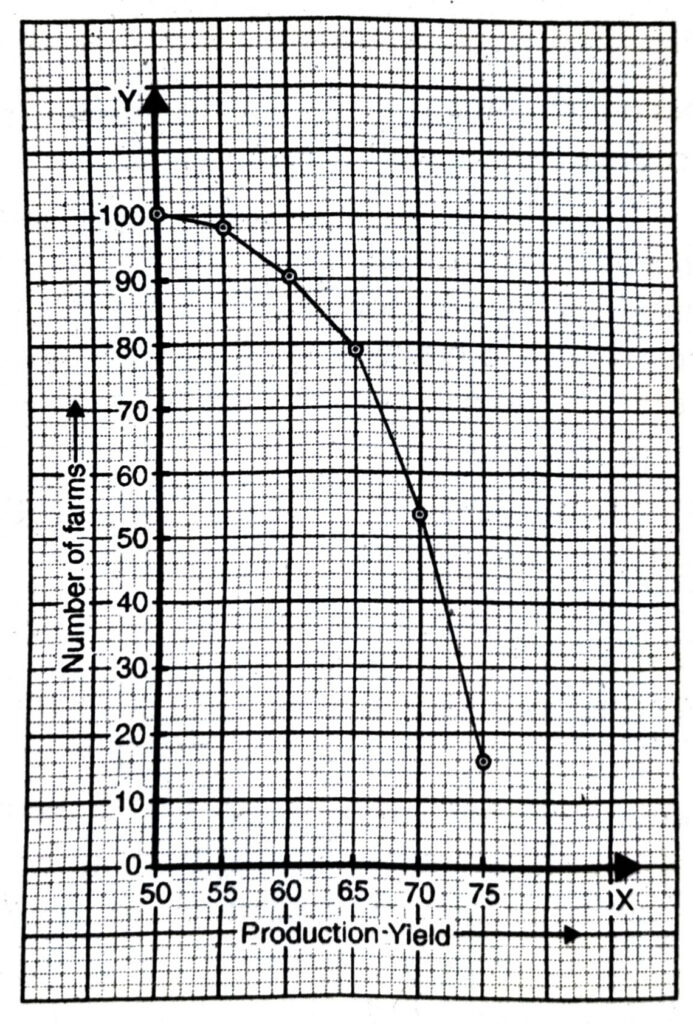
Follow on Facebook page – Click Here
Google News join in – Click Here
Read More Asia News – Click Here
Read More Sports News – Click Here
Read More Crypto News – Click Here